Joseph Oliver was born about 50 miles west of New Orleans in Aben, Louisiana (a majority of sources erroneously cite Abend) to Nathan Oliver and Virginia "Jennie" Jones. His actual birth location may have been the Salsburg Plantation where Nathan may have been employed as a laborer. Note that the difficult-to-read 1900 census appears to have perpetuated a misspelling for Joe's mother as Jessie in many write-ups on the composer, an understandable error, and very few use the correct derivative of Jennie or Ginnie. His year of birth is also disputed as the 1900 census indicates a probable 1885 birth for Joe (although the 5 looks like it was written over a 4), and his 1918 draft record states it as 1881. The 1920 census puts him at 1884, which seems the most likely, even though an older sister had been born exactly a year before. Jennie had apparently been married to or involved with four different men, as Joseph's older siblings were Fanny Davis (11/1878) and Adele Hadford (12/1883), and her last name as of 1900 was Jones, showing as divorced. Out of fifteen children born to her only six survived to 1900. The other three were difficult to locate in the census records.
Joe's mother and sisters moved to New Orleans, the future hotbed of early jazz, soon after his birth. Growing up in the Crescent City, Oliver was surrounded by the influence of the melting pot of music. It was here that styles ranging from French compositions and Cakewalks were mixed with early Creole music and Mariachi instrumental influences, to eventually become jazz. Given the constant flux of his mother's and sisters' partners, his home life may not have been very stable in the early years. Joe initially learned to play trombone, but quickly switched to the cornet. An accident in his late teens blinded Oliver in his left eye, so he took to playing while sitting in a chair or leaning against the wall, keeping a derby hat tilted over the bad eye. As of 1900 Jennie and her children were living at 1106 Nashville Avenue in the 14th Ward of New Orleans, along with two grandchildren who were born to Fanny. Jennie and Fanny were working as cooks, Adele as a servant, and Joe as a day laborer.
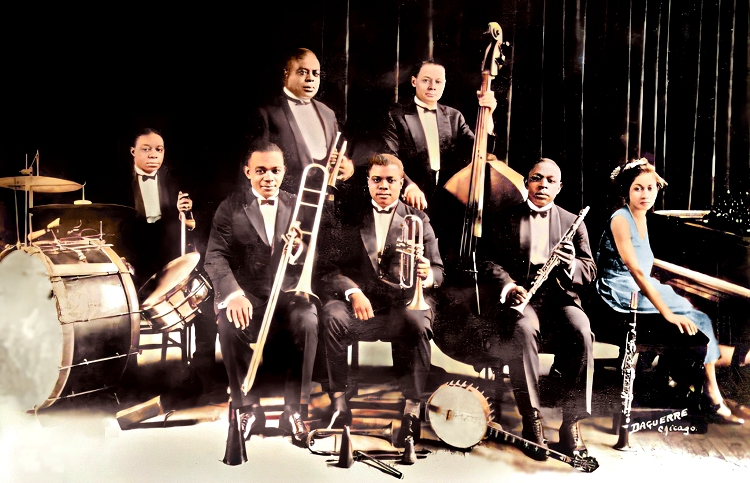 |
Oliver started his professional career in New Orleans, getting paid to play, around 1908. His 1910 census listing is a mess, and the story it tells is unclear. He was living as a boarder at 1438 Religious Street in the 1st Ward of New Orleans, working as a driver for a coal company. While he showed as being married, possibly to Eliza Baptiste (spelled Baptist in the record), the status of husband is marked out and changed to roomer, as it is for Eliza's daughter Eugenia. His age was shown as 30, not the last time an exaggeration like that would be used. As was often the case, it is probable that Joe was not in when the enumerator came around, and many guesses were made, including his age. No marriage certificate to Baptiste has been located.
While it seems less likely that Joe was married in the 1910 record, on July 13, 1911 Oliver did marry Estelle "Stella" Dominick, who was already a single mother with a 6 year old daughter, Ruby. His age showed this time as 26, which further reinforces the 1884 year of birth. Joe played where there was work, including marching bands, various brass bands, second lines and occasional small ensembles. As his notoriety increased, particularly after the demise of the fabled Buddy Bolden, Oliver was sought out not just to perform but to mentor as well. He became the primary mentor and teacher of young Louis Armstrong, who affectionately dubbed him "Papa Joe." Joe even gave Satchmo the first cornet that he would own, which is now in the Smithsonian Institution. Oliver also cited his influences in turn during this period as Bunk Johnson, Freddie Keppard and Manuel Perez, all first rate New Orleans cornetists.
Joe was also reportedly intimidated by these players for some time, slowly gaining confidence throughout the 1910s. It is clear that he eventually caught on, as illustrated by an incident relayed in an interview by New Orleans pianist and bandleader Richard M. Jones: "Freddie Keppard was playin' in a spot across the street and was drawin' all the crowds. I was sittin' at the piano, and Joe Oliver came over to me and commanded in a nervous harsh voice, 'Get in B-flat.' He didn't even mention a tune ... Joe walked out on the sidewalk, lifted his horn to his lips, and blew the most beautiful stuff I have ever heard. People started pouring out of the other spots along the street to see who was blowing all that horn. Before long, our place was full and Joe came in smiling, and he said, 'Now, that bastard won't bother me no more.' From then on, our place was full every night."
Among the groups that Joe played with in New Orleans were the Onward Brass Band, Original Superior Orchestra, Eagle Band, The Magnolia, the Olympia Band, and the band of Edward "Kid" Ory playing at Pete Lala's. It was Ory who dubbed Joe as "King" Oliver while they were still in New Orleans, forming the Kid Ory and King Oliver Band. Joe also had a fascination with musical textures that led to experimentation using variety of improvised mutes, including hats, bottles, cups, and hand shapes to alter or enhance the sound of his horn. By the dawn of jazz in 1917, Oliver and his peers had already been playing it for a few years, and continued to advance the improvisatory aspects of it. That same year Oliver would form a band of his own playing at Lala's.
Early in 1918, the U.S. Navy closed down the well-organized if somewhat notorious Storyville District brothels in New Orleans, putting more than just the prostitutes out of work. With some of the lure of the district gone, and with the war in full swing, the number of paying visitors to New Orleans and its many drinking venues dropped off markedly. So in mid-1918 both Oliver and Ory moved to Chicago along with scores of other musicians both to find steadier gigs and some escape from growing racial prejudice in the South.
There they worked at Bill Bottoms' Dreamland Café and appeared in clarinetist Lawrence Duhé's and bassist Bill Johnson's Original Creole Orchestra at the Dreamland until at least 1920. Oliver's September 1918 draft record not only confirms he was in Chicago, but working at the Dreamland by that time. Aside from some advertising in local papers, Joe is next shown in Chicago in the January 1920 census as employed by the Dreamland Cafe, and living with Stella and Ruby in a rooming house. Among the personnel he played with around that time were Johnny Dodds and Lil Hardin, both eventual members of his own famous band. Joe also worked at the Deluxe Café and the Pekin Cabaret which had been the home of pianist Joe Jordan for many years.
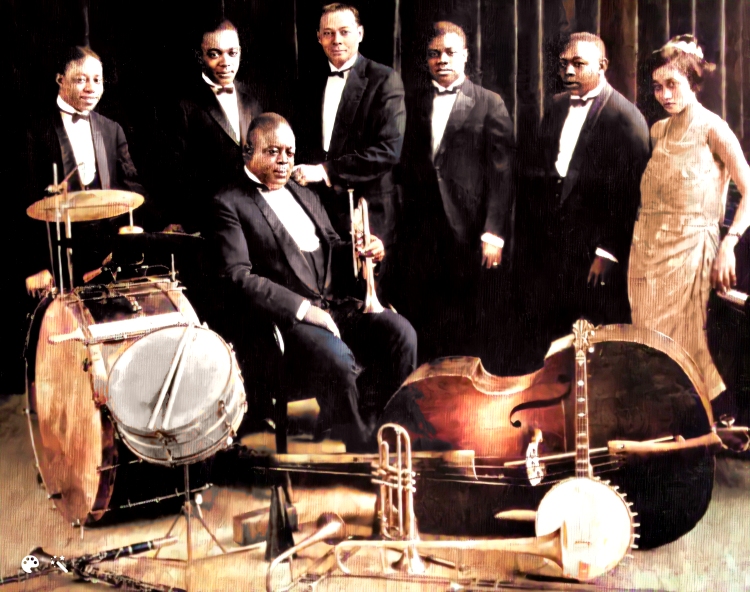 |
Joe toured with these bands at various times, and spent most of mid-1921 through early 1922 in the San Francisco area in groups of his own construction, including an early incarnation of King Oliver's Creole Jazz Band. When he returned to Chicago in May 1922 Joe restructured a bit and King Oliver's Creole Jazz Band was soon based at the former Royal Gardens which was now called Lincoln Gardens. Among the first moves he made was to send a telegram to his former student who now reigned as New Orleans' finest trumpeter, Louis Armstrong. Louis had not played outside of New Orleans except for a brief stint in St. Louis, so when he arrived in Chicago in August 1922 it was a totally new venture for him Joe also recruited or retained Honore Dutrey on trombone, Lil Hardin on piano, Stump Evans on C-melody saxophone, Johnny St. Cyr on banjo and guitar, his former leader Bill Johnson on bass, Johnny Dodds on clarinet, and Johnny's brother Baby Dodds on drums. This group set the standard for what would eventually be termed "Traditional Jazz."
Oliver's Creole Jazz Band was a big draw virtually every night they played during the next two years. The group's 1923 sessions for the Gennett label created jazz benchmarks that many groups still follow, and they helped to spread the joyful playing of both Oliver and Armstrong to enthusiasts all around the country. Musicians, both black and white, would venture out to Lincoln Gardens after their own gigs were over just to hear the duets and duels between Armstrong and Oliver. Some players actually wrote down notes of riffs on their cuffs or napkins, hoping to recreate them. After hours, which were already late, some of the musicians would retreat elsewhere for prohibition alcohol (not always very good) and muggles (marijuana cigarettes) while exchanging even more musical ideas.
The April through December 1923 acoustic recordings for Gennett Records in Richmond, Indiana, were among the first recordings of jazz played by an African American band, a field in which the pioneering label was ahead of the game.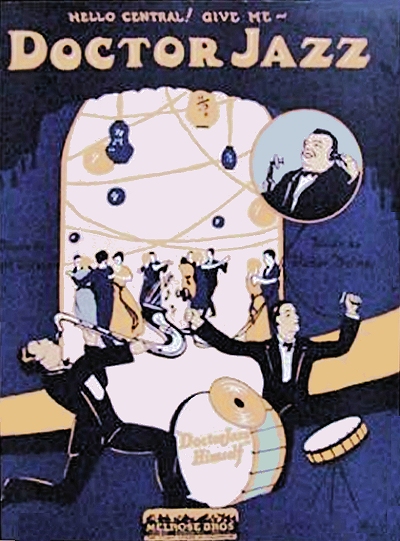 They showed amazing agility and cohesiveness within the group, and primarily between its two leaders. Among the standouts were Chimes Blues, featuring Armstrong's first solo chorus, and Canal Street Blues, which has since become a standard. The relaxed atmosphere and casual air of Chicago both emboldened Oliver and wreaked havoc with him as well. He enjoyed baseball games, but also pool games and gambling. He started to consume great quantities of food as well and grew in size while also in stature. His habits would eventually lead him to physical and medical difficulties, compounded by financial problems. However, some of his initial downfall came from other egos within the band.
They showed amazing agility and cohesiveness within the group, and primarily between its two leaders. Among the standouts were Chimes Blues, featuring Armstrong's first solo chorus, and Canal Street Blues, which has since become a standard. The relaxed atmosphere and casual air of Chicago both emboldened Oliver and wreaked havoc with him as well. He enjoyed baseball games, but also pool games and gambling. He started to consume great quantities of food as well and grew in size while also in stature. His habits would eventually lead him to physical and medical difficulties, compounded by financial problems. However, some of his initial downfall came from other egos within the band.
 They showed amazing agility and cohesiveness within the group, and primarily between its two leaders. Among the standouts were Chimes Blues, featuring Armstrong's first solo chorus, and Canal Street Blues, which has since become a standard. The relaxed atmosphere and casual air of Chicago both emboldened Oliver and wreaked havoc with him as well. He enjoyed baseball games, but also pool games and gambling. He started to consume great quantities of food as well and grew in size while also in stature. His habits would eventually lead him to physical and medical difficulties, compounded by financial problems. However, some of his initial downfall came from other egos within the band.
They showed amazing agility and cohesiveness within the group, and primarily between its two leaders. Among the standouts were Chimes Blues, featuring Armstrong's first solo chorus, and Canal Street Blues, which has since become a standard. The relaxed atmosphere and casual air of Chicago both emboldened Oliver and wreaked havoc with him as well. He enjoyed baseball games, but also pool games and gambling. He started to consume great quantities of food as well and grew in size while also in stature. His habits would eventually lead him to physical and medical difficulties, compounded by financial problems. However, some of his initial downfall came from other egos within the band.Lincoln Gardens burned down shortly after the band's debut there, which added to rising tensions within the group. Feeling they weren't receiving their fair share of composition and recording royalties, many members of Oliver's band, reportedly led by Baby Dodds, split with him in mid-1924. While Louis and Lil, who were both now married, remained behind, Mrs. Armstrong was increasingly put off by her talented husband still playing second trumpet to Oliver. With Lil's urging, and perhaps intervention, Louis being lured to New York by composer/arranger/bandleader Fletcher Henderson, in order to form his own legendary band. Left nearly alone by this abandonment, he found other musicians and played as King Oliver's Jazz Band through the remainder of the year, cutting some tracks on the same labels as he had previously. The removal of the word Creole may have been an intentional move to negate any racial identification of the group. They were now recording on OKeh, Columbia and the local Paramount label.
A typical advertisement found in the Reading Eagle of May 13, 1924, indicated that they toured as a dance band: "King Oliver and His Original Jazz Band, recording for Columbia, Okeh and Gennett records,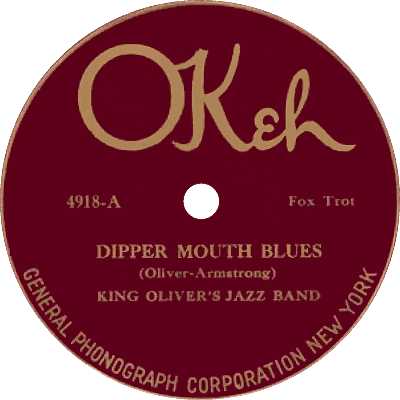 will appear at the Casino, on Wednesday evening. It is one of the biggest attractions of the season. For [dancers] to miss this musical organization is to miss one of the best dance treats of the season. The orchestra at the musical convention at the Drake Hotel, Chicago, won instant recognition and was booked for a tour of the East."
will appear at the Casino, on Wednesday evening. It is one of the biggest attractions of the season. For [dancers] to miss this musical organization is to miss one of the best dance treats of the season. The orchestra at the musical convention at the Drake Hotel, Chicago, won instant recognition and was booked for a tour of the East."
 will appear at the Casino, on Wednesday evening. It is one of the biggest attractions of the season. For [dancers] to miss this musical organization is to miss one of the best dance treats of the season. The orchestra at the musical convention at the Drake Hotel, Chicago, won instant recognition and was booked for a tour of the East."
will appear at the Casino, on Wednesday evening. It is one of the biggest attractions of the season. For [dancers] to miss this musical organization is to miss one of the best dance treats of the season. The orchestra at the musical convention at the Drake Hotel, Chicago, won instant recognition and was booked for a tour of the East."As that group dissolved late in 1924, Joe then played with Dave Peyton's Orchestra at the Plantation Café, located at 35th Street and Grand Boulevard in Chicago. As that group was reformed, complete with a three saxophone section, Oliver took it over in 1925, renaming it the Dixie Syncopators. They continued to play at the Plantation, and made recordings for Brunswick Records and its Vocalion subsidiary. However, the new group was unable to capture or recreate the spirit of the early Creole Jazz Band.
Among the friendships that Oliver had was an on and off relationship with fellow New Orleans musician Ferdinand "Jelly Roll" Morton. Both had been working with the Melrose Brothers publishing firm to put their pieces in print, and Oliver incorporated Morton tunes in his band's repertoire. Morton did come to hear, and at least once get on stage and start playing with Oliver's band. In December 1924 Oliver and Morton laid down a pair of duets at (Orlando R.) Marsh Laboratories in Chicago for the short-lived Autograph label, using Marsh's new electrical recording process that would quickly become the industry standard. Although the company quit recording within a year, the Morton/Oliver duets remained best sellers beyond that time. After two years at the Plantation Café, Oliver's nightly venue burned down and he was left again with no place to play. So he took his Dixie Syncopators on the road for a while.
Their tour ultimately went to the Savoy Ballroom in Harlem, New York City, in May 1927, where he played as Joe Oliver's Jazz Demons. The band was supposedly there on "an indefinite engagement." However, contentions that Oliver and the group decided to stay in New York City from that time are contradicted by continued recordings in Chicago in 1927 and 1928, and advertisements such as this notice for a gig at the Wonderland Park Ballroom in Baltimore, Maryland, which appeared on June 24, 1927 in The Afro-American: "What promises to be one of the biggest musical sensations of the year is the scheduled appearance of King Oliver and his Dixie Syncopators at Wonderland Park next Monday and Tuesday Evenings.
King Oliver, who is one of the bright recording stars on Vocalion records is bringing to Baltimore one of the greatest syncopated organizations every seen or heard in the city." At some point in 1928, Oliver started spending more time in New York City than Chicago, but had not yet fully relocated.
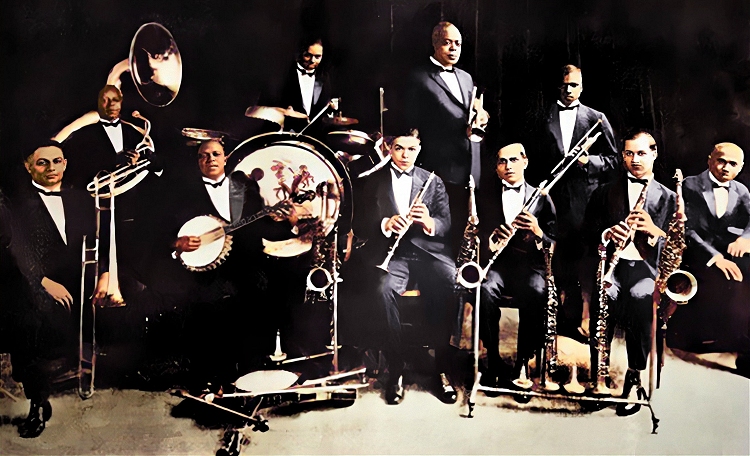 |
While allured by the rapidly expanding music scene in New York, and having briefly reunited with Armstrong, though not as a performer, Oliver seriously considered the merits of staying there, but continued to return to Chicago with his group. There they recorded his West End Blues in July, 1928, which Armstrong would grab immediately and turn into one of the finest jazz classics of the era, complete with a difficult to copy opening fanfare. Given that the King Oliver group's final recording date for Vocalion in Chicago was in September 1928, he likely made his move east that month or in October. One recording date for the Dixie Syncopators on Brunswick was logged in New York in mid November, but with some change in personnel.
From there on, Oliver's career started on a downward slide. He managed to be excised from the Savoy after demanding more than they were willing to pay for his group, although this may have been a management issue. Joe had a problem with managers who constantly stole from him or give him raw deals. Through one of them he inexplicably turned down a regular gig at the famous Cotton Club, again reportedly over the amount of pay. That opened up a spot for Edward "Duke" Ellington who would quickly rise to fame there, and for Cab Calloway who would be Harlem's voice of the 1930s. Most of his income at this time was from pick-up gigs and recording dates.
In addition to his large appetite, Oliver also had a sweet tooth that led lead to serious dental problems, making cornet playing quite painful. He lost leadership of his band in late 1928 to pianist Luis Russell who kept the Dixie Syncopators name. Victim of yet another mutiny, did a little recording on his own as well as with friend and sometimes co-composer Clarence William's groups. The new King Oliver Orchestra signed a contract with Victor in early 1929 and recorded a number of tracks for that company from early 1929 to late 1930. However, many of Joe's investments and life savings had disappeared with the stock market crash of 1929 and 1930, as well as the collapse of the Chicago bank that held his funds, complicating his financial situation.
He also was not able to play on many of the Victor tracks due to his advancing gum disease. This band would again go under during the difficult period of the Depression when the public was simply not buying records. In spite of concerted efforts, Oliver's whereabouts in the 1930 census were not found. It is assumed he may have been divorced by this time. He did manage to cut a few more tracks for Brunswick in early 1931, then he simply stopped recording at all.
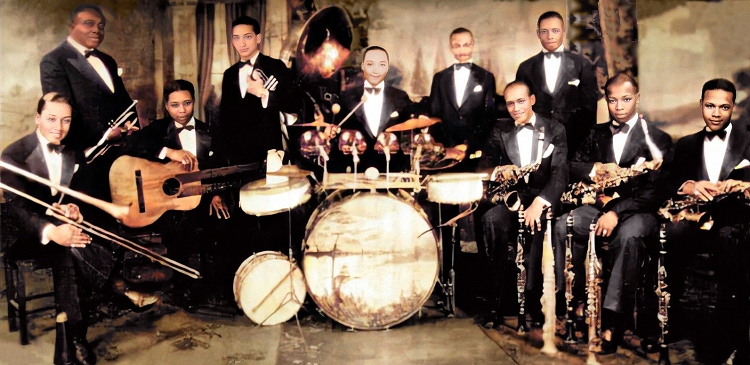 |
Oliver formed yet another new band in Nashville in late 1931, the last year he would record. In spite of frequent circuit tours in the American South over the next few years, King Oliver was quickly becoming a forgotten name. Some of the advertising for the group may have been exaggerated or false, or referred to performance venues played at by individual members, as this one concerning a theater group dance at a local women's club from the Spartanburg, South Carolina Herald-Journal of December 23, 1936, indicates: "Dancing will begin at 10 o'clock and continue until 2:30 o'clock with King Oliver and his orchestra, now touring the South after a long engagement at Manhattan's Cotton club. These musicians are also well known as Victor recording artists." As the "long run" at the Cotton Club at any time with a couple of years of that performance was not confirmed, some of the information is suspect.
As the career of Armstrong continued to soar through the 1930s, the dethroned King eventually could play no longer without extreme pain, went broke, and settled in Savannah, Georgia, after being stranded there during his final tour. It was later reported that Armstrong, on tour with his group in Savannah, encountered the rapidly deteriorating Oliver while he was there and provided him with new clothes and some money before moving on. It was likely the last time they ever saw each other. Joe worked as a janitor in a poolroom, Wimberly's Recreation Hall, with a schedule of up to fifteen hours most days.
Joe remained in Savannah at a rooming house at 508 Montgomery Street until his untimely death at 52 in April 1938. In what has long been perceived as an insult by jazz fans everywhere, there were no immediate obituaries printed in the major papers. That may have simply been a matter of practicality, as those in Savannah who handled the death simply did not know who to inform or how important Oliver had been to the music world. His body was transported to New York City where Joseph "King" Oliver was buried at Woodlawn Cemetery in the Bronx. The funeral was attended by only a few of his close friends. Some of them would also later be interred at Woodlawn.
It was three years later in San Francisco that Lu Watters, Turk Murphy and Wally Rose would form the Yerba Buena Jazz Band, which was dedicated to reviving the works of the great traditional jazz masters with some ragtime thrown in. Both King Oliver and Louis Armstrong were their primary targets in their recordings of 1941, 1942 and 1946. Through the efforts of the YBJB, and later such Oliver contemporaries including his friend Kid Ory, King Oliver's music once again was once again swinging and hasn't stopped since. He got more of his full due in the Ken Burns documentary Jazz which further introduced him to a new generation in the 1990s. Nearly a century later revelers still enjoy the Sugar Foot Stomp or singing along with Doctor Jazz. In 2007 Oliver was honored as a charter member of the Gennett Records Walk of Fame where the earliest black jazz records were made in Richmond, Indiana, some nine decades prior. Long live the King.
Most of the information for this biography was taken from public and government records, recording logs and labels, directories, newspapers and periodicals of the era. Some additional helpful information was derived from the stupendous Jelly Roll Morton-centric website of Mike Meddings, doctorjazz.co.uk, from the autobiography of Louis Armstrong, and from the book Jazz, compiled from the PBS series of the same name. Many of Oliver's recordings can be heard at RedHotJazz.com.

 Compositions
Compositions